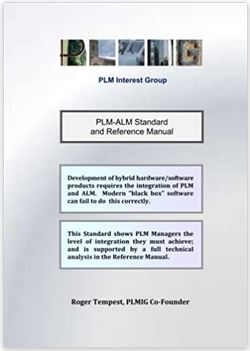|
PLM Interest Group |
|||||||||||||||||||||||
|
|
|
|
|||||||||||||||||||||
|
|
|
|||||||||||||||||||||
|
|
|
|
|||||||||||||||||||||
|
PLM-ALM Standard and Reference Manual
SCM : ALM : PLM
For companies that manufacture products that contain both hardware and software, the problems of successful product data management have existed for a long time. The subject has recently become known as Application Lifecycle Management (ALM), but in the mid-2000s it was called Software Configuration Management (SCM). Whichever acronym is used, the problems of integrating with PLM are the same, and the PLMIG has the most concise and practical solution. Integration
Terminology has moved forward but solutions have not. Some vendors have provided applications that can link software development to PLM, but they tend to be "black box" solutions that hide their workings from the user. What is worse for the PLM Team is that these applications focus on synchronising product development as it initially happens - in the "here and now". But PLM also has a requirement to maintain the complete product configuration as it existed at defined points in the past. Lack of attention to this stores up potentially serious problems for the future. The PLM-ALM Standard
Hardware design and software design are different activities, and PDM and ALM are different systems. The most effective way of operating them together is to use the systems for the purposes for which they were intended, and to maintain a simple but rigorous interface between the two. Integration is nice to have, but synchronisation is necessary. The PLM-ALM Standard resolves this by defining two levels of synchronisation: Current and Historical.
The Standard is extremely concise. Once the PLM and ALM Teams know what they are aiming for, they can find their own best method of achieving it. The PLM-ALM Reference Manual
The Standard comes with a Reference Manual that contains all of the underlying theory, and explains this logic in a way that any PLM Manager can understand. The Methodology removes uncertainties about the best way to manage PDM and SCM data, allowing implementation of a single, practical solution with the minimum of time and effort. It can be applied to any environment in which products that consist of both physical and software components are developed. The Reference Manual makes clear the differences between hardware and software design so that the problems can be understood. It sets out a straightforward and practical solution that can be applied to any company that creates hybrid products, and explains how to apply it so that the correct PDM-SCM relationship can be maintained in a particular organisation. This not only helps PLM and ALM specialists to work together effectively, but is essential background information for activities such as system selection and planning. The Table of Contents gives a clear picture of the structure of the Standard and the Reference Manual. How to Purchase the Standard
The PLM-ALM Standard and Reference Manual is provided with Q&A support to PLMIG Members, so you will receive a copy if you join with any class of Membership. Alternatively, you may buy hard copies from Amazon or electronic copies from the Store. For more information about PLM-ALM, or the Standard itself, contact plm-alm@plmig.com.
© Copyright 2025 PLM Interest Group |
||||||||||||||||||||||
| <<< Return Home | |||||||||||||||||||||||
|
|
|
|
|||||||||||||||||||||





